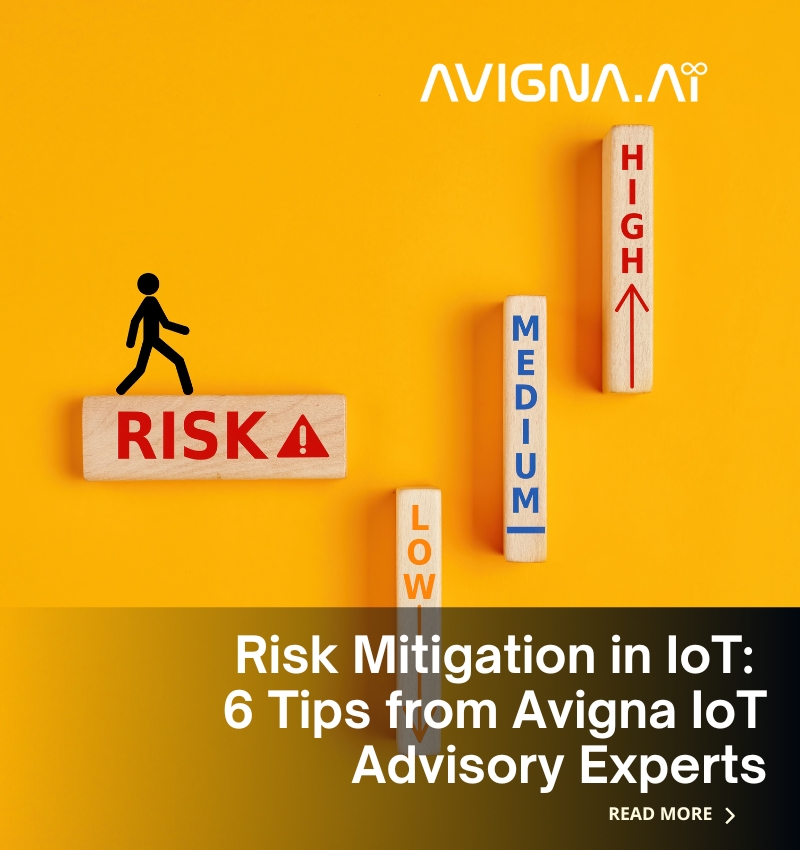Risk Mitigation in IOT:6 Tips from Avigna IOT Advisory Experts
The Internet of Things, or IoT experts, has connected us in ways we never dreamed possible. IoT consulting services technology is used in almost every industry, from Smart Homes to wearable devices. However, with the increased connectivity comes a host of security threats that need to be addressed and various strategies that can be implemented for risk mitigation. Six key areas related to managing risks associated with connected devices:
- Knowing objectives and capabilities,
- Monitoring systems,
- Assessing potential vulnerabilities,
- Developing an incident response plan,
- Conducting employee training programs and
- Setting up appropriate security measures.
Knowing one’s goals and capabilities will make it easier for users to understand which type of risks they might face and maintain greater control over device usage after proper assessment.
Additionally, staying vigilant through system monitoring should always remain a high priority. Implementing effective incident response plans before any issues arise to help minimize disruption during any unanticipated cyber-attack or emergency.
Furthermore, designing employee training programs about safe handling practices provides a systematic means for employees to stay informed regarding ever-changing threat vectors and what actions can prevent them from becoming victims themselves.
Device Authentication & Authorization
To ensure data is securely stored and processed, organizations must deploy strong authentication to guarantee that only authorized users can access the devices. Access control protocols such as password protection, biometric identification methods, and two-factor authentication should be implemented to secure sensitive resources.
Organizations must also establish a comprehensive authorization policy governing which users can access digital assets and IoT installation services at any time. By deploying effective security protocols, authorities can ensure unauthorized individuals are unable to view or manipulate corporate information.
Data Encryption technology is essential for protecting confidential data from being viewed by malicious actors or stolen during transmission over public networks like the Internet. Companies must determine the best encryption strategies based on their specific system requirements. Hence, they meet industry compliance standards and internal policies for protecting proprietary information assets.
Data should be encrypted both in transit and when stored in various formats, enabling more robust data protection solutions rather than relying strictly on user authentication controls alone.
End-to-end Data Encryption
Full-stop Data encryption is a crucial tool for protecting data. End-to-end encryption secures data sent between two or more sites by encrypting the data at its source and decoding it only when it reaches its destination. This reduces the possibility of accessing information while en route and lowers the risk of manipulation or interception.
Using shared keys between the sender and recipient, end-to-end encryption, and decryption ensure no other parties may access the data. Similarly, it restricts bad hackers from trying to get into a network or computer system even if they successfully decode the signals.
Additionally, since there is less identifying information connected with securely shared communications than with conventional communication protocols like email services and instant messaging programs that do not employ this technology, end-to-end encryption offers anonymity for users who may be worried about privacy. As such, end-to-end Data Encryption provides several advantages when keeping sensitive digital assets safe online.
Also Read: How to choose the right IOT advisory for your organization?
Secure Firmware & Software Updates
Modern software and firmware can be complex and open to security vulnerabilities, but comprehensive updates can help protect against malicious code or attacks. Regularly updating your firmware and applications is a great way to keep your devices safe from outside influences.
Digital manufacturers regularly issue important updates that address potential security concerns in their products, with the latest versions ensuring better protection against malware, viruses, etc.
Furthermore, many devices now come with automated update notifications, so you don’t have to spend time manually keeping up on available patches and upgrades. Keeping yourself informed about the process makes it easier when (and if) an unexpected alert does appear to ensure everything is working as intended for complete peace of mind online or offline- depending upon your preferences.
To keep systems up-to-date and properly functioning, companies must ensure that all hardware and software are running the latest firmware versions and other necessary documents.
As such, most IT departments advise companies to maintain a system for securely delivering firmware updates as part of a comprehensive policy procedure that should meet standards set by industry regulators. This includes checking with vendors regularly to ensure that any security patches or updates are received promptly.
Network-level Protections
Network-level Protections are another type of protection that can be used in information security. These security measures guard against external dangers like viruses, malicious assaults, and other cyber-security concerns for the data and network.
Firewalls to block unwanted access, intrusion detection systems to spot unusual behavior on a network or communications system, regular antivirus scans to find dangerous software, encryption methods to safeguard sensitive data, and secure traffic management systems to regulate user authentication and authorization requests are a few examples of network-level security measures.
In addition to these technical solutions, there are also organizational policies to help enforce network-level protections, such as employee education on cyber-safety practices or limiting physical access points into an organization’s networks.
Ultimately, network-level safeguards maintain the integrity of any communication flow within your company and provide essential protection against intruders seeking out critical data resources for unlawful purposes.
Also Read: How to deal when a vendor goes ghost in IoT projects?
Device Resilience & Fail-safes
There are several types of technological gadgets, networks, and applications nowadays. When it comes to ensuring that all these components are safe, dependable, and robust in the face of interruptions or unplanned outages, it may be challenging for many firms to know where to start.
Even though they might not be able to prevent every potential service disruption, businesses make some sure steps ready if something goes wrong. The most important part is ensuring devices have fail-safes built into their structure so they don’t fall victim to common disruptions like malware or natural disasters.
Backup plans should also be in place for when those fail-safes fail, and data must always remain protected and available even if an individual device goes down due to power loss or damage caused by weather.
Additionally, users themselves must practice responsible tech hygiene while installing updates regularly, backing up data on multiple mediums, then storing them safely offline, and taking other preventative measures such as against phishing scams and viruses will help keep systems running smoothly no matter the situation.
By taking proactive action now, organizations can prepare for any future emergency while protecting their digital assets and personnel from threats, great & small.
Monitoring & Anomaly Detection
Monitoring and anomaly Detection are two important considerations in any system architecture. They must ensure that everything is operating as it should and that no unexpected behaviors are occurring.
Monitoring allows users to monitor the system’s typical behavior, while anomaly detection can spot changes from the norm. When something abnormal occurs, something unusual is happening with the system, which needs further investigation.
Anomaly detection models use machine learning algorithms such as clustering, classification, or deep learning networks to analyze vast amounts of data for patterns and anomalies or outliers within them (Fawcett & Provost 1997).
The model then flags instances that do not fit these patterns, which may indicate an issue. Once detected, they can allow further exploration of what type of anomaly occurred and take appropriate action based on its severity/impact.
As technology advances, the increased complexity of our networks requires more sophisticated methods for monitoring and detecting anomalies. Automated tools are used to provide better and faster insights than manual monitoring can provide. These tools can detect threats early on, alerting administrators when an unusual or potentially malicious event is detected.
Network security solutions may use analytics to identify trends that indicate suspicious activity or check traffic logs against known blacklisted sources. Anomaly detection also provides valuable information about a system’s health by identifying out-of-pattern events that could lead to a device malfunction or critical service disruption.
With these automated solutions in place, organizations have access to real-time data with which they can quickly respond to any potential breach attempt and protect their IT infrastructure from costly losses due to downtime or lost productivity.

Conclusion
Although risk mitigation through IoT consulting services is an ongoing process, it can potentially revolutionize the efficiency and security of different businesses by proactively addressing risks.
That being said, this work can be greatly strengthened through collaboration between IT professionals and industry IoT experts by leveraging their collective skills and experience in managing data protection, compliance requirements, encryption standards, etc., businesses have a greater chance of successful risk mitigation strategies for IoT consulting services deployments.
Through these insights from various IoT experts, we can understand best practices that must be adopted while working with technologies such as Internet-of-Things (IoT). Maximizing performance gains while offering top-notch safety measures for operations enabled by IoT consulting devices presents novel challenges for which currently no tried and tested solutions are available.
But with continued vigilance from cybersecurity and IT professionals coupled with reliable guidance from industry bodies such as NIST, organizations should remain well prepared to face any existing or emerging threats against their network infrastructure powered by connected devices. Minimize risks and maximize the potential of technology in your business transformation. Ask us how.



